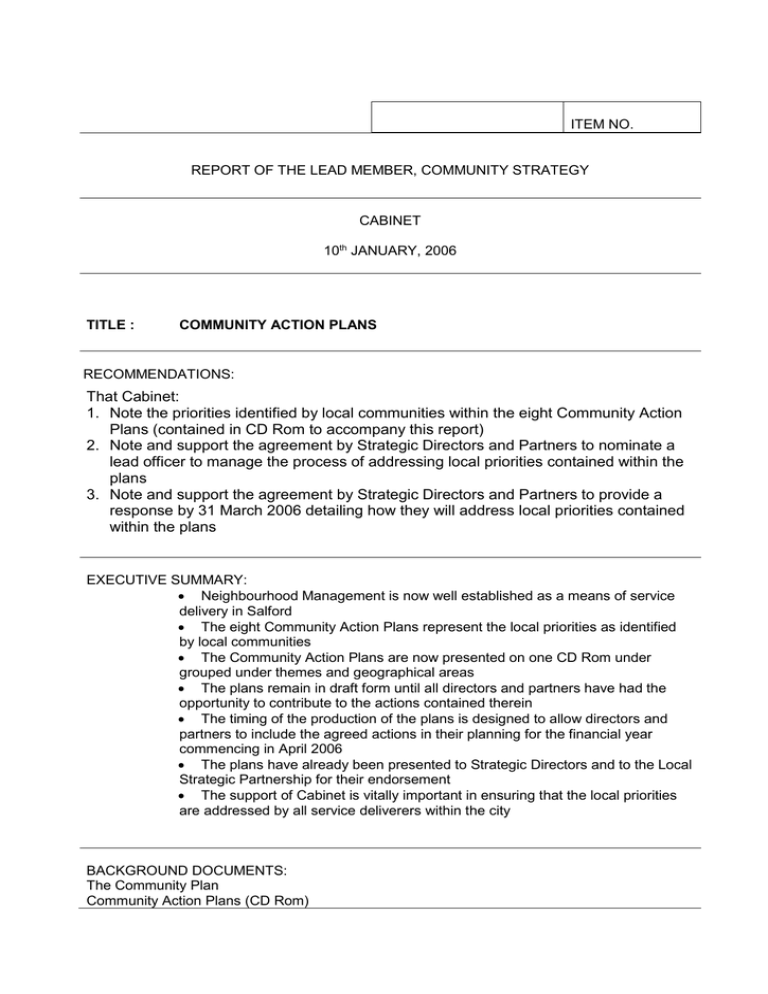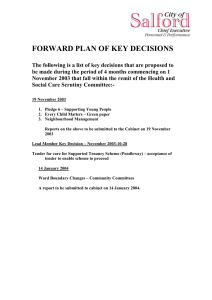That Cabinet:
advertisement

ITEM NO. REPORT OF THE LEAD MEMBER, COMMUNITY STRATEGY CABINET 10th JANUARY, 2006 TITLE : COMMUNITY ACTION PLANS RE RECOMMENDATIONS: That Cabinet: 1. Note the priorities identified by local communities within the eight Community Action Plans (contained in CD Rom to accompany this report) 2. Note and support the agreement by Strategic Directors and Partners to nominate a lead officer to manage the process of addressing local priorities contained within the plans 3. Note and support the agreement by Strategic Directors and Partners to provide a response by 31 March 2006 detailing how they will address local priorities contained within the plans EXECUTIVE SUMMARY: Neighbourhood Management is now well established as a means of service delivery in Salford The eight Community Action Plans represent the local priorities as identified by local communities The Community Action Plans are now presented on one CD Rom under grouped under themes and geographical areas The plans remain in draft form until all directors and partners have had the opportunity to contribute to the actions contained therein The timing of the production of the plans is designed to allow directors and partners to include the agreed actions in their planning for the financial year commencing in April 2006 The plans have already been presented to Strategic Directors and to the Local Strategic Partnership for their endorsement The support of Cabinet is vitally important in ensuring that the local priorities are addressed by all service deliverers within the city BACKGROUND DOCUMENTS: The Community Plan Community Action Plans (CD Rom) CONTACT OFFICER: Brian Wroe, Assistant Director (Community Services). Tel. 793 2287 WARD (S) TO WHICH REPORT RELATE (S): Citywide PURPOSE OF REPORT 1. To inform Cabinet of the development of the eight Community Action Plans and to present those plans on CD Rom 2. To seek the support of Cabinet in asking Strategic Directors to address the local priorities and to seek ways to commit mainstream resources to addressing those priorities 3. To seek the approval of Cabinet for the process to date and for the proposed next steps BACKGROUND Neighbourhood Management Neighbourhood Management, in its present form, has been in place in Salford since early 2004. Each of the city’s eight Community Committee areas has its own neighbourhood team, each led by a Neighbourhood Manager. Neighbourhood Management is now the established way for the city council and its partners to Engage effectively with local communities Meet the needs of communities and improve neighbourhoods Close the gap between the best and worst performing areas This way of working is responsive to local communities. It enables us to work closely with those communities, to identify their priorities and to make our service delivery more responsive to those priorities. Effective Neighbourhood Management allows us to demonstrate many of the requirements under Comprehensive Performance Assessment, in particular those associated with community engagement. It is fundamental to delivering the Best Value Review of Community Engagement Improvement Plan. It is also an important tool in delivering the national outcomes for the Safer, Stronger Communities Fund and for our Local Public Service Agreements. The Production of Community Action Plans (CAPs) CAPs are produced by each of the eight Community Committees under the guidance of the Neighbourhood Manager. The CAPs identify the priorities for action by a range of partners. They have been produced Through extensive consultation with local people specifically for the CAP or by partners in the course of their work Based upon the local knowledge of members of the neighbourhood team Based upon the local knowledge of elected members who are key members of Community Committees Based upon demographic information about the area from a variety of sources For the first time, Community Action Plans have been produced on CD Rom for ease of use. The plans are arranged under the headings of the 7 pledges / themes and are entirely consistent with the city’s Community Plan. They are also organised on a locality basis. Some priorities cut across more than one theme. Where that has been identified, reference is made in the right hand column to assist in the delivery of crosscutting work. Purpose of Community Action Plans (CAPs) Each CAP represents a draft action plan for directors and partners to add to or amend. The CAPs are intended to Identify the priorities of the community through a process of consultation and involvement Turn those priorities into deliverable actions Identify how those actions can be achieved through mainstream working Directors and Partners have been asked to Identify resources to carry out actions allocated to them as lead agency Include the priorities within service plans Agree timescales Work in partnership to address the priorities and to lead the work where that is appropriate The main aim of this process is to ensure that, where possible, the priorities of communities contained within the CAPs become mainstream work for the city council and its partners. Timescale The timing of the production of CAPs will enable directorates and partner agencies to use the plans to influence their budget setting, resource allocation and service planning for the financial year commencing April 2006. It has been requested that each directorate and partner agency identifies a named lead officer who will manage the process through their internal structures and provide clear responses to Neighbourhood Managers by 31 March 2006 as to how they will help to address local priorities. Directorates and partner agencies are asked to take a broad view of priorities across the board and not to simply restrict their attention to the priorities which refer specifically to them. It is felt that all can help to deliver on a wide range of priorities in keeping with our philosophy of partnership working. While most priorities require a partnership approach in order to address them adequately, very often the main responsibility falls to one directorate or agency in particular. For example, while the improvement of a park may require the help of the police to tackle anti social behaviour and the Youth Service to engage with young people, the main responsibility may lie with Environment Directorate. It is asked that, where appropriate, the highlighted lead directorate or partner agency take primary responsibility for seeking solutions with others. The neighbourhood manager will invariably be involved in those discussions however he or she must not be expected to take primary responsibility for every issue. Directorates and partner agencies may need to gain a better understanding of how they can address local priorities and how this might fit with existing activities and priorities. The nominated lead officer has been invited to discuss the detail with Neighbourhood Managers concerning actions they can deliver, resource issues and timescales. After March 2006 a report will be produced which will identify how CAPs have influenced mainstream resources and proposing the next steps in order to meet local priorities. In April 2006 each CAP will be published in its final version including amendments made by directors and partners. This version will provide a basis for monitoring the delivery of commitments made by directors and partners. RESOURCE IMPLICATIONS The city has successfully devolved some finance to local communities, managed by Budget Groups in the eight neighbourhoods. This has enabled communities to make decisions about prioritising expenditure. Further discussion will take place concerning possible further devolvement of budgets. Strategic Directors and partner agencies are now being asked to consider how they can realign their budget setting and move resources in response to the identified local priorities. Sufficient time has been allowed to influence service planning for the financial year commencing in April 2006. This approach represents a change in the way that we carry out our core business. It presents us with the opportunity to become even more responsive to the wishes of the communities we serve. CONCLUSION Community Action Plans have now been produced for the first time on CD Rom. They are more consistent than ever in their content and format. Neighbourhood Management has been identified as one of the key methods for service delivery by the council and by our partners. We now have the opportunity to further enhance our service delivery and to make those services responsive to local communities. Cabinet is asked to endorse this approach and to lend its support to the proposals contained in this report.





